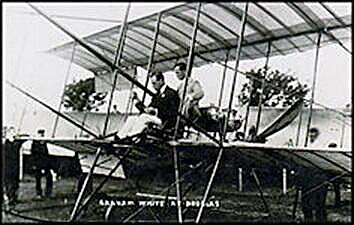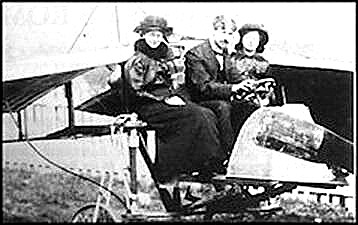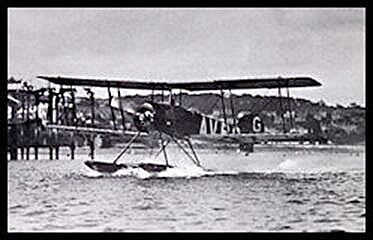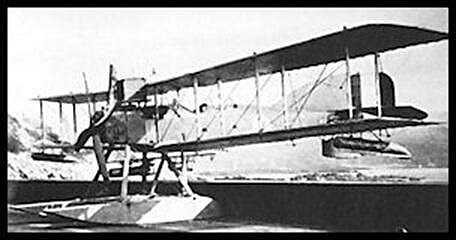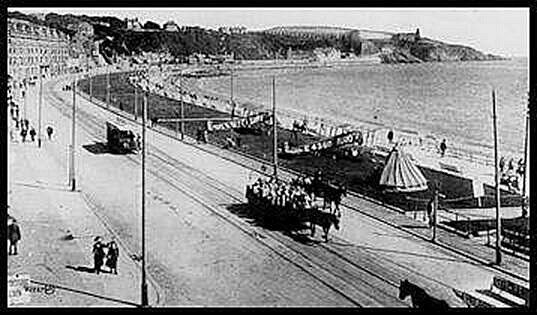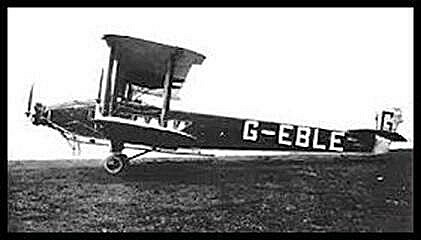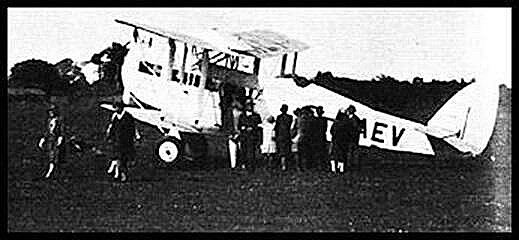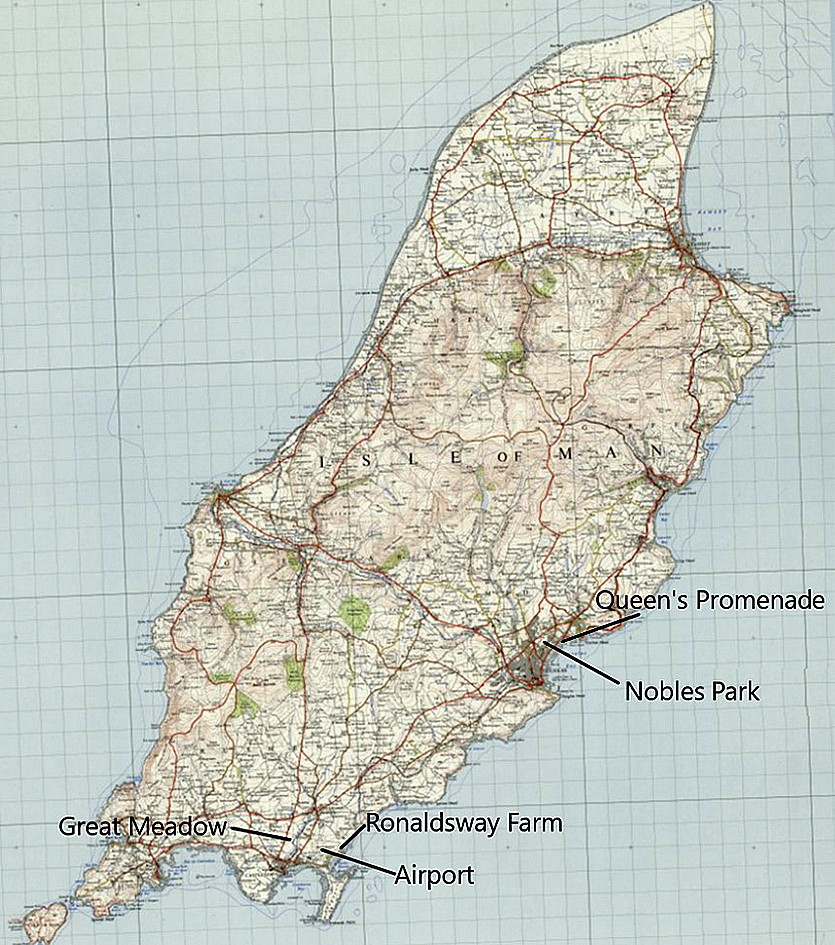Isle of Man flying sites
Note: This map is a general view of the Isle of Man and its relationship to the mainland and Eire.
ISLE OF MAN
NOTE: There are several other sites on the Isle of Man already listed and you can see these if you search by 'County'.
ISLE of MAN: Temporary aerodrome? (Initially RONALDSWAY FARM)
Note: When Sir Alan Cobham landed at RONALDSWAY FARM it was still a temporary aerodrome. Used mainly for aircraft arriving during the TT races.
NOTES: The Isle of Man was listed as the 46th venue in the 1929 Sir Alan Cobham's Municipal Aerodrome Campaign. Starting in May and ending in October this Tour visited one hundred and seven venues. Mostly in England it included two venues in Wales and eight in Scotland.
The aircraft he used was the DH61 'Giant Moth' G-AAEV named 'Youth of Britain'. The punishing schedule he set himself seems astonishing today. See my article, Sir Alan Cobham 1929, for more information.
ISLE of MAN: Temporary aerodrome?
NOTES: The Isle of Man is listed as a venue for the CD Barnard Air Tours “Flying Circus” operation in June 1931. It appears they operated from RONALDSWAY FARM.
ISLE of MAN: Civil regional airport (Possibly CASTLETOWN?)
NOTES: In June 1933 Blackpool & West Coast Air Services commenced a Liverpool, Blackpool and Isle of Man service. But where did they land on the island? I think I can now answer this question; I believe they used RONALDSWAY and the service commenced in July 1933. Can this be confirmed?
Also in 1933 British Amphibious Air Lines also started a Blackpool to Isle of Man service - but where did they land on the island?
The same goes for Midland and Scottish Air Ferries who also started a Isle of Man service in 1933 and Hillman Airways in 1934. I have since found fairly conclusive proof (?) that Hillman Airways flew into CASTLETOWN.
Without any doubt CASTLETOWN became RAF RONALDSWAY in WW2?
BREAKING NEWS!!!
In May 2024, Mr Graham Frost, a great friend of this 'Guide', discovered this fabulous resource. Titled "Isle of Man Aviation pre 1930s".
See also: http://www.island-images.co.uk
"In 1902 the first aerial vehicle was to be seen in the Isle of Man when a Royal Navy gas balloon measuring 60ft high by 45ft diameter, was flown from Peveril Square in Douglas for a free flight ending in Dumfriesshire, Scotland."
"There was to be no further aerial activity in the Isle of Man until July 1911 when a temporary aerodrome was established in Nobles Park, Douglas, for demonstration flying by two early flying machines, a Farman and a Bleriot, the aircraft having been shipped to the island by the IOM steam packet. In the event only the Farman took to the air, as the Bleriot was damaged in transit. In August 1912 the Noble Park aerodrome was activated again when Gustave Hamel conducted demonstration flights in a Morane Saulnier, including the island's first 'Air Mail' flight from Douglas to Peel." (My note, Peel is on the west side of the island, roughly 9nm NW of Douglas).
I have done a big search of Blériot aircraft types and can find nothing even remotely resembling this. Indeed, I doubt such a machine could fly with three seated abreast - the drag would be enormous given the engines available in those days - let alone lifting such a weight. I suspect it might have been a 'mock-up' constructed simply for taking pictures. Unless of course, you know otherwise?
"In August 1914 an aerodrome was established on Queen's Promenade, Douglas, with a Bleriot monoplane using the beach for take-off and landing and an Avro 504 float plane operating from the water, being hauled up on to the promenade at the end of the day. Both of these aircraft gave pleasure flights to the public which proved to be a great success. As with the previous visiting aircraft, they arrived to and departed from the island courtesy of the Isle of Man Steam Packet."
"During World War One, great strides were taken in the development of aircraft and the first flight 'across the water' were made to the island, by Short 184 seaplanes operated by the Royal Navy. They operated from Lake Windermere in Cumbria and carried mail as well as looking out for German U-boat activity in the Irish Sea. After the war the first flight to the island by a Manxman was carried out by Captain Elgie Jefferson who flew a Bristol Fighter from Hooton Park in Cheshire, landing at Great Meadow near Castletown in January 1919 before continuing the next day to Stranraer, Scotland."
"In the Spring of 1919 the Queen's Promenade aerodrome was active again for pleasure flying with Avro 504s and in July of that year Captain Howard Pixton made what is regarded as the first commercial flight to the island. Using an Avro 504 floatplane he flew copies of the 'Daily News' from Windermere for sale to holidaymakers. Flights continued for two weeks and passengers could be carried for the price of 10 guineas."
"The following year there was more pleasure flying from Douglas beach but after objections and a petition signed by 20 people, permission was withdrawn and there was to be no more flying from the island until 1925 during the TT races when a de Havilland DH9 flew copies of the 'Motorcycle News' over, landing on Douglas Head. This became a regular event over the next few years."
My note: The nearest Avro 504 is still wearing its military serial number. This is of interest, but still quite common, as from the 20th April 1919 all British civilian aircraft had to have a CofA, (Certificate of Airworthiness), and must carry markings in an official form. The other Avro 504 is not complying either, having a large 'Avro' sign on its sides.
1928 - First flights from Ronaldsway
"The first use of Ronaldsway as an aerodrome occurred on June 5th 1928 when Captain Olley, flying an Imperial Airways Handley Page HP27 Hampstead G-EBLE, landed in a large field on Ronaldsway Farm bringing in 'The Motorcycle' for TT visitors."
"The Hampstead was a large three motor biplane and after delivering the papers, was made available for pleasure flying from Ronaldsway. The aircraft had a wingspan of 75ft and at 60ft in length could carry up to 14 passengers in its cabin. As was usual in those days the pilot and mechanic sat outside and braved the elements! During TT the following year Ronaldsway was used again for both 'The Motorcycle' and also the 'Daily Mail' during the TT race period, the latter being flown in by a DH61 Giant Moth." My note: I was intrigued to learn that when enclosed cabins were being introduced for aircrew on airliners, there was initially quite a lot of resistence to the idea. But, after talking to even modern pilots who regularly fly open cockpit types, they say that a lot can 'felt' regarding how the aeroplane is performing in a variety of different ways.
"The Summer of 1929 also saw the arrival of Sir Alan Cobham who was touring Great Britain to promote aviation. He arrived at Ronaldsway in DH61 Giant Moth G-AAEV 'Youth of Britain' on August 2nd from Blackpool, and carried out a series of demonstration flights, mainly to young people from the island. He also encouraged the establishment of a permanent aerodrome for the Isle of Man."
We can thank Mr Mike Holder for kindly providing this map of the principal flying sites mentioned above.
"In April 1933 two famous aviators visited Ronaldsway, Amy Johnson, flying DH60G Moth G-ABVW 'Jason 4' and her husband Jim Mollison, flying DH80A Puss Moth G-ACAB 'Desert Cloud'."
ISLE of MAN AIRPORT see also RONALDSWAY
We'd love to hear from you, so please scroll down to leave a comment!
Leave a comment ...
Copyright (c) UK Airfield Guide















